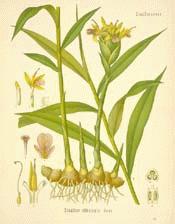
Botanical.com Home Page

|
Garden Ginger
(Zingiber officinale)
Click on graphic for larger image
|
Ginger
Botanical: Zingiber officinale (ROSC.)
Family: N.O. Zingiberaceae
---Part Used---Root.
---Habitat---Said to be a native of Asia. Cultivated in West Indies, Jamaica, Africa.
---Description---Naturalized in America after the discovery of that country by the Spaniards. Francisco de Mendosa transplanted it from the East Indies into Spain, where Spanish-Americans cultivated it vigorously, so that in 1547 they exported 22,053 cwt. into Europe.
It is now cultivated in great quantities in Jamaica and comes into this country dried and preserved. The root from the West Indies is considered the best. Also imported from Africa, there are several varieties known in commerce. Jamaica or White African is a light-brown colour with short rhizome, very pungent. Cochin has a very short rhizome, coated red-grey colour. 'Coated or Uncoated' is the trade term for peel on or skinned. Green Ginger is the immature undried rhizome. Preserved Ginger is made by steeping the root in hot syrup. Ratoon is uncultivated Ginger. Ginger is a perennial root which creeps and increases underground, in tuberous joints; in the spring it sends up from its roots a green reed, like a stalk, 2 feet high, with narrow lanceolate leaves; these die down annually. The flowering stalk rises directly from the root, ending in an oblong scallop spike; from each spike a white or yellow bloom grows. Commercial Ginger is called black or white, according to whether it is peeled or unpeeled; for both kinds the ripened roots are used, after the plant has died down. The black are scalded in boiling water, then dried in the sun. The white (best) are scraped clean and dried, without being scalded. For preserve young green roots are used- they are scalded and are washed in cold water and then peeled. The water is changed several times, so that the process takes three or four days. The tubers are then put into jars and covered with a weak syrup; this is changed after a few days' soaking for a stronger syrup, which is again changed for a still stronger one. The discarded syrups are fermented and made into a liquor called 'cool drink'; a few drops of chloroform or chloride are generally added to the preserve to prevent insects breeding in it. Ginger flowers have an aromatic smell and the bruised stem a characteristic fragrance, but the root is considered the most useful part of the plant, and must not be used under a year's growth. The peeling has to be done very thinly or the richest part of the resin and volatile oil is lost. It is sometimes soaked in lime-juice instead of plain water, and the colour is improved by a final coating of chalk. The Chinese fresh Ginger is grated into powder. African and Cochin Ginger yield the most resin and volatile oil. The root must be kept in a dry place, or it will start growing and is then spoilt. The odour of Ginger is penetrating and aromatic, its taste spicy, hot and biting; these properties are lost by exposure. The most common adulterants are flour, curcuma, linseed, rapeseed, the hulls of cayenne pepper and waste ginger.
---Constituents---Volatile oil, acrid soft resin, resin insoluble in ether and oil, gum, starch, lignin, vegeto matter, asmazone, acetic acid, acetate of potassa, sulphur.
---Medicinal Action and Uses---Stimulant, carminative, given in dyspepsia and flatulent colic excellent to add to bitter infusions; specially valuable in alcoholic gastritis; of use for diarrhoea from relaxed bowel where there is no inflammation. Ginger Tea is a hot infusion very useful for stoppage of the mensesdue to cold, externally it is a rubefacient. Essence of Ginger should be avoided, as it is often adulterated with harmful ingredients.
---Dosage---Infusion: 1/2 oz. bruised or powdered root to 1 pint boiling water is taken in 1 fluid ounce. Dose, 10 to 20 grains.
---Preparation---Fluid extract, 10 to 20 drops. Tincture, B.P., 1/2 to 1 drachm. Syrup, B.P. and U.S.P., 1/2 to 1 drachm. Oleoresin, U.S.P., 1/2 grain.
[Top]
Common Name Index
A MODERN HERBAL Home Page
Bear in mind "A Modern Herbal" was written with the conventional wisdom of the early 1900's. This should be taken into account as some of the information may now be considered inaccurate, or not in accordance with modern medicine.
© Copyright Protected 1995-2025 Botanical.com
|

